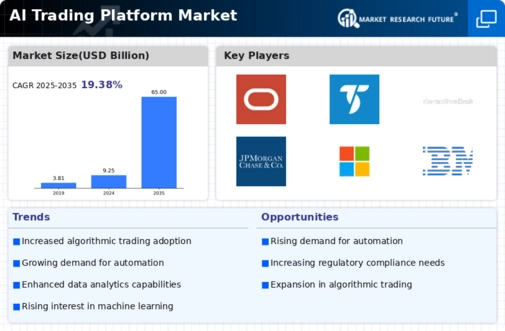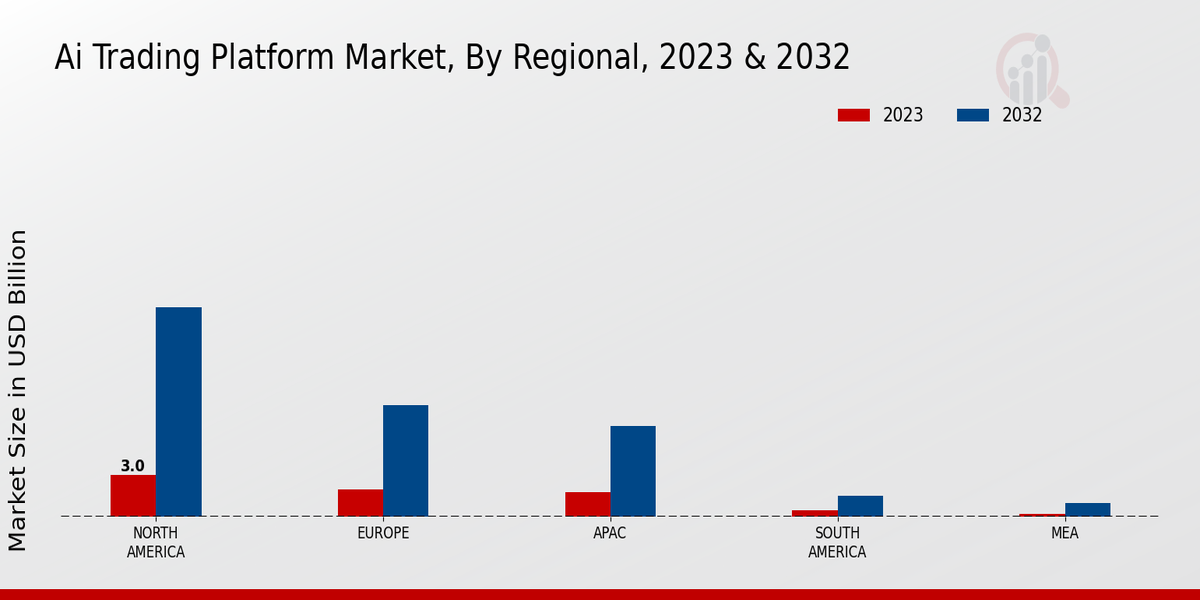Market Growth Projections
The Global AI Trading Platform Market Industry is poised for substantial growth, with projections indicating a market size of 9.25 USD Billion in 2024 and an anticipated expansion to 65.0 USD Billion by 2035. This growth trajectory suggests a compound annual growth rate of 19.39% from 2025 to 2035, reflecting the increasing adoption of AI technologies in trading. The market's evolution is driven by various factors, including advancements in machine learning, big data analytics, and regulatory support. As the industry continues to innovate, the potential for AI trading platforms to reshape the financial landscape becomes increasingly evident.
Integration of Big Data Analytics
The integration of big data analytics into the Global AI Trading Platform Market Industry serves as a crucial driver for growth. The ability to analyze large volumes of data from diverse sources enables traders to gain insights into market dynamics and consumer behavior. This analytical capability enhances decision-making processes, allowing for more strategic trading approaches. As firms increasingly adopt big data technologies, the demand for AI trading platforms is expected to rise. The anticipated compound annual growth rate of 19.39% from 2025 to 2035 underscores the importance of big data in shaping the future of trading and investment strategies.
Regulatory Support for AI Innovations
Regulatory support for AI innovations plays a pivotal role in the Global AI Trading Platform Market Industry. Governments and regulatory bodies are increasingly recognizing the potential of AI technologies to improve market efficiency and transparency. This support fosters an environment conducive to the development and deployment of AI trading platforms. As regulations evolve to accommodate these technologies, market participants are likely to embrace AI solutions more readily. This trend may contribute to the projected market growth, as firms seek to comply with regulations while leveraging AI to enhance their trading capabilities.
Growing Interest in Algorithmic Trading
The growing interest in algorithmic trading significantly impacts the Global AI Trading Platform Market Industry. As more investors and institutions recognize the benefits of algorithmic strategies, the demand for AI trading platforms is expected to rise. These platforms offer sophisticated tools that enable traders to implement complex algorithms and optimize their trading strategies. The increasing availability of educational resources and training programs further fuels this interest, empowering a broader audience to engage in algorithmic trading. This trend is likely to drive market growth, as more participants seek to capitalize on the advantages offered by AI-driven trading solutions.
Advancements in Machine Learning Algorithms
The Global AI Trading Platform Market Industry is significantly influenced by advancements in machine learning algorithms. These innovations enable platforms to process and analyze financial data with unprecedented accuracy and speed. Enhanced predictive analytics capabilities allow traders to identify market trends and make informed decisions based on real-time data. As machine learning continues to evolve, it is likely to drive further adoption of AI trading platforms, contributing to the market's growth. By 2035, the market could expand to 65.0 USD Billion, showcasing the potential of these technologies to transform trading practices and improve investment outcomes.
Increasing Demand for Automated Trading Solutions
The Global AI Trading Platform Market Industry experiences a notable surge in demand for automated trading solutions. Investors and traders increasingly seek to leverage AI technologies to enhance trading efficiency and accuracy. This trend is driven by the need for rapid decision-making and the ability to analyze vast datasets in real-time. As a result, the market is projected to reach 9.25 USD Billion in 2024, reflecting a growing reliance on AI-driven platforms. The automation of trading processes not only minimizes human error but also allows for the execution of complex trading strategies that were previously unattainable, thereby reshaping the trading landscape.















